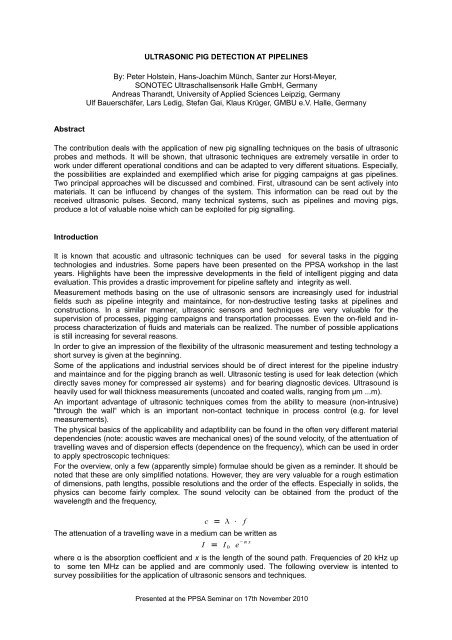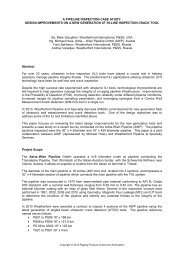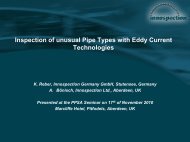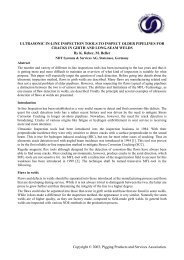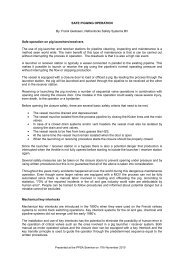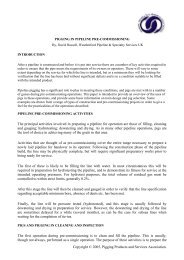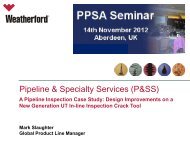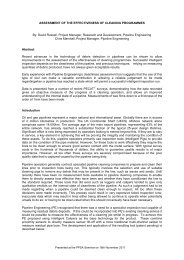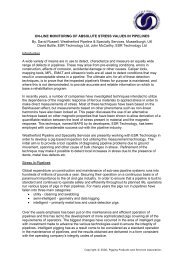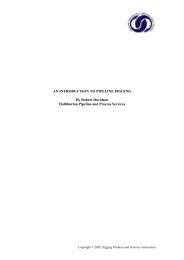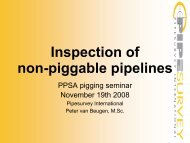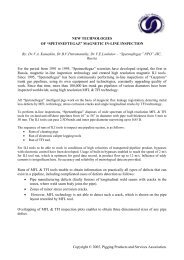ultrasonic pig detection at pipelines - PPSA, the Pigging Products ...
ultrasonic pig detection at pipelines - PPSA, the Pigging Products ...
ultrasonic pig detection at pipelines - PPSA, the Pigging Products ...
Create successful ePaper yourself
Turn your PDF publications into a flip-book with our unique Google optimized e-Paper software.
Abstract<br />
ULTRASONIC PIG DETECTION AT PIPELINES<br />
By: Peter Holstein, Hans-Joachim Münch, Santer zur Horst-Meyer,<br />
SONOTEC Ultraschallsensorik Halle GmbH, Germany<br />
Andreas Tharandt, University of Applied Sciences Leipzig, Germany<br />
Ulf Bauerschäfer, Lars Ledig, Stefan Gai, Klaus Krüger, GMBU e.V. Halle, Germany<br />
The contribution deals with <strong>the</strong> applic<strong>at</strong>ion of new <strong>pig</strong> signalling techniques on <strong>the</strong> basis of <strong>ultrasonic</strong><br />
probes and methods. It will be shown, th<strong>at</strong> <strong>ultrasonic</strong> techniques are extremely vers<strong>at</strong>ile in order to<br />
work under different oper<strong>at</strong>ional conditions and can be adapted to very different situ<strong>at</strong>ions. Especially,<br />
<strong>the</strong> possibilities are explainded and exemplified which arise for <strong>pig</strong>ging campaigns <strong>at</strong> gas <strong>pipelines</strong>.<br />
Two principal approaches will be discussed and combined. First, ultrasound can be sent actively into<br />
m<strong>at</strong>erials. It can be influcend by changes of <strong>the</strong> system. This inform<strong>at</strong>ion can be read out by <strong>the</strong><br />
received <strong>ultrasonic</strong> pulses. Second, many technical systems, such as <strong>pipelines</strong> and moving <strong>pig</strong>s,<br />
produce a lot of valuable noise which can be exploited for <strong>pig</strong> signalling.<br />
Introduction<br />
It is known th<strong>at</strong> acoustic and <strong>ultrasonic</strong> techniques can be used for several tasks in <strong>the</strong> <strong>pig</strong>ging<br />
technologies and industries. Some papers have been presented on <strong>the</strong> <strong>PPSA</strong> workshop in <strong>the</strong> last<br />
years. Highlights have been <strong>the</strong> impressive developments in <strong>the</strong> field of intelligent <strong>pig</strong>ging and d<strong>at</strong>a<br />
evalu<strong>at</strong>ion. This provides a drastic improvement for pipeline saftety and integrity as well.<br />
Measurement methods basing on <strong>the</strong> use of <strong>ultrasonic</strong> sensors are increasingly used for industrial<br />
fields such as pipeline integrity and maintaince, for non-destructive testing tasks <strong>at</strong> <strong>pipelines</strong> and<br />
constructions. In a similar manner, <strong>ultrasonic</strong> sensors and techniques are very valuable for <strong>the</strong><br />
supervision of processes, <strong>pig</strong>ging campaigns and transport<strong>at</strong>ion processes. Even <strong>the</strong> on-field and inprocess<br />
characteriz<strong>at</strong>ion of fluids and m<strong>at</strong>erials can be realized. The number of possible applic<strong>at</strong>ions<br />
is still increasing for several reasons.<br />
In order to give an impression of <strong>the</strong> flexibility of <strong>the</strong> <strong>ultrasonic</strong> measurement and testing technology a<br />
short survey is given <strong>at</strong> <strong>the</strong> beginning.<br />
Some of <strong>the</strong> applic<strong>at</strong>ions and industrial services should be of direct interest for <strong>the</strong> pipeline industry<br />
and maintaince and for <strong>the</strong> <strong>pig</strong>ging branch as well. Ultrasonic testing is used for leak <strong>detection</strong> (which<br />
directly saves money for compressed air systems) and for bearing diagnostic devices. Ultrasound is<br />
heavily used for wall thickness measurements (unco<strong>at</strong>ed and co<strong>at</strong>ed walls, ranging from µm ...m).<br />
An important advantage of <strong>ultrasonic</strong> techniques comes from <strong>the</strong> ability to measure (non-intrusive)<br />
"through <strong>the</strong> wall“ which is an important non-contact technique in process control (e.g. for level<br />
measurements).<br />
The physical basics of <strong>the</strong> applicability and adaptibility can be found in <strong>the</strong> often very different m<strong>at</strong>erial<br />
dependencies (note: acoustic waves are mechanical ones) of <strong>the</strong> sound velocity, of <strong>the</strong> <strong>at</strong>tentu<strong>at</strong>ion of<br />
travelling waves and of dispersion effects (dependence on <strong>the</strong> frequency), which can be used in order<br />
to apply spectroscopic techniques:<br />
For <strong>the</strong> overview, only a few (apparently simple) formulae should be given as a reminder. It should be<br />
noted th<strong>at</strong> <strong>the</strong>se are only simplified not<strong>at</strong>ions. However, <strong>the</strong>y are very valuable for a rough estim<strong>at</strong>ion<br />
of dimensions, p<strong>at</strong>h lengths, possible resolutions and <strong>the</strong> order of <strong>the</strong> effects. Especially in solids, <strong>the</strong><br />
physics can become fairly complex. The sound velocity can be obtained from <strong>the</strong> product of <strong>the</strong><br />
wavelength and <strong>the</strong> frequency,<br />
c = ⋅ f<br />
The <strong>at</strong>tenu<strong>at</strong>ion of a travelling wave in a medium can be written as<br />
− x<br />
I = I 0 e<br />
where α is <strong>the</strong> absorption coefficient and x is <strong>the</strong> length of <strong>the</strong> sound p<strong>at</strong>h. Frequencies of 20 kHz up<br />
to some ten MHz can be applied and are commonly used. The following overview is intented to<br />
survey possibilities for <strong>the</strong> applic<strong>at</strong>ion of <strong>ultrasonic</strong> sensors and techniques.<br />
Presented <strong>at</strong> <strong>the</strong> <strong>PPSA</strong> Seminar on 17th November 2010
Applic<strong>at</strong>ions in Pipeline Industry and Service (selection)<br />
• active pulse methods<br />
→ liquid level estim<strong>at</strong>ion<br />
→ recognition of different liquids<br />
→ measurement of wall thickness<br />
→ level limits<br />
→ inspection and monitoring of sediment<strong>at</strong>ion and deposits<br />
→ measurement of <strong>the</strong> accumul<strong>at</strong>ion of sand, debris, incrust<strong>at</strong>ion in tanks, <strong>pipelines</strong>, barrels<br />
→ advanced NDT 1 -tasks (e.g. "intelligent“ <strong>pig</strong>ging, m<strong>at</strong>erial testing)<br />
• passive sound emission methods<br />
→ acoustic <strong>detection</strong> of moving sand in <strong>pipelines</strong><br />
→ amount of debris<br />
→ condens<strong>at</strong>e inspection (e.g. in valves and traps)<br />
→ <strong>detection</strong> of leakages<br />
→ flowing sand and debris in <strong>pipelines</strong><br />
→ monitoring of m<strong>at</strong>erials and constructions<br />
Ultrasonic Sensors and Probes<br />
One important key for an optimal applic<strong>at</strong>ion of <strong>the</strong> <strong>ultrasonic</strong> technologies and <strong>the</strong> complete<br />
exploit<strong>at</strong>ion of <strong>the</strong>ir huge and vers<strong>at</strong>ile potential is caused by <strong>the</strong> gre<strong>at</strong> variety of available sensors. An<br />
adapted sensor solution and probe construction can be found for almost any problem. An impression<br />
is given by figure 1 which shows some sensors developed and sold by SONOTEC.<br />
Figures 1. Examples of industrial sensors –<br />
from left: contact technique probes, immersion probes, mini<strong>at</strong>ur probes, multi-channel probes,<br />
low frequency probes, phased-array probe, angle transmitter-receiver probes<br />
Two typical examples stand for <strong>the</strong> applic<strong>at</strong>ion of <strong>ultrasonic</strong> sensor technologies in many branches of<br />
industry. The working principle - <strong>the</strong> non-intrusive measurement through a wall - stands (amongst<br />
o<strong>the</strong>rs) for an important advantage of <strong>the</strong> method. Many vari<strong>at</strong>ions can be derived.<br />
Figure 2. Measurement through <strong>the</strong> wall – a typical advantage for <strong>ultrasonic</strong> measurements.<br />
Left: level control of liquids (travel time and intensity are used for <strong>the</strong> estim<strong>at</strong>ion of filling<br />
heights or for <strong>the</strong> control of defined filling levels, right: measurement of wall thickness (travel<br />
time of <strong>the</strong> echoe(s) of a transmitted pulse)<br />
1 NDT - Non destructive Testing<br />
Presented <strong>at</strong> <strong>the</strong> <strong>PPSA</strong> Seminar on 17th November 2010
Experimental Approachs and Technical Solutions for Pig Signalling<br />
Pipeline Monitoring and Pig Loc<strong>at</strong>ion for Crude Oil Pipelines<br />
A method of <strong>ultrasonic</strong> <strong>pig</strong> signalling for oil <strong>pipelines</strong> has been developed by SONOTEC [Son08].<br />
The method works like a photoelectric guard. An <strong>ultrasonic</strong> signal is permanently sent through <strong>the</strong><br />
pipeline. A part of <strong>the</strong> signal will be reflected by <strong>the</strong> back wall and <strong>the</strong>n received (this is possible for<br />
<strong>the</strong> combin<strong>at</strong>ion of steel walls and oil, see next chapter). When a <strong>pig</strong> comes to pass <strong>the</strong> position of <strong>the</strong><br />
probe, it deceler<strong>at</strong>es or prevents <strong>the</strong> reflection. The principle is explained by means of figure 3. An<br />
extension of <strong>the</strong> method and <strong>the</strong> commercial probe (optional) enables <strong>the</strong> recognition of different<br />
products if <strong>the</strong> sound velocities of this products differ. Caused by <strong>the</strong> physical principles described<br />
above, some commercial and oper<strong>at</strong>ional advantages of <strong>the</strong> use of <strong>ultrasonic</strong> technology are obvious.<br />
It can be easily installed in non-intrusive clamp-on technology which does not require any process<br />
interruption. The pipeline will not be affected due to <strong>the</strong> non-contact character of <strong>the</strong> measurement.<br />
Experimental <strong>at</strong>tempts have been done for gas <strong>pipelines</strong> too. It is known, th<strong>at</strong> pinging of ultrasound<br />
through <strong>the</strong> wall into <strong>the</strong> gas can succeed for high pressure. However, a certain minimum pressure<br />
must be guaranteed.<br />
Figure 3. Standard configur<strong>at</strong>ion of a transmitting <strong>ultrasonic</strong> probe for <strong>the</strong> applic<strong>at</strong>ion <strong>at</strong> crude<br />
oil <strong>pipelines</strong><br />
Pig Signalling Methods for Gas Pipelines<br />
The technology for liquid <strong>pipelines</strong> cannot be simply transferred for gas filled <strong>pipelines</strong> for physical<br />
reasons which are outlined below. It is well known in <strong>the</strong> <strong>PPSA</strong> community th<strong>at</strong> <strong>the</strong>re is gre<strong>at</strong> variety<br />
for <strong>pig</strong>s with respect to construction, weight, diameter, sensor instrument<strong>at</strong>ion, pricing and so on.<br />
Cleaning <strong>pig</strong>s, caliper <strong>pig</strong>s, intelligent <strong>pig</strong>s will provide new demanding tasks for <strong>pig</strong> signalling in gas<br />
<strong>pipelines</strong>. Fur<strong>the</strong>rmore, different pipeline diameters, different gas pressures, different scenarios of<br />
<strong>pig</strong>ging (<strong>pig</strong> velocity, stop and run), <strong>the</strong> existence of unco<strong>at</strong>ed and co<strong>at</strong>ed <strong>pipelines</strong> (Cor06) make <strong>the</strong><br />
situ<strong>at</strong>ion complic<strong>at</strong>ed for oper<strong>at</strong>ors and service as well.<br />
Pig Detection by a Non-intrusive Active Method<br />
The use of <strong>the</strong> direct signal p<strong>at</strong>h of acoustic pinging through <strong>the</strong> steel walls of a pipeline is complic<strong>at</strong>ed<br />
or even almost completey prevented by <strong>the</strong> reflection properties of <strong>the</strong> involved m<strong>at</strong>erials and fluids.<br />
This can be understood by a look on <strong>the</strong> effectivity of <strong>the</strong> reflection or transmission of an acoustic<br />
wave through <strong>the</strong> wall-gas-system.<br />
R= Z 1−Z 2<br />
Z 1Z 2<br />
R is <strong>the</strong> reflection coefficient, where Z1 and Z2 denote <strong>the</strong> impedances of <strong>the</strong> m<strong>at</strong>erials (e. g. steel and<br />
n<strong>at</strong>ural gas). The impedance Z results from <strong>the</strong> product of <strong>the</strong> sound velocity and density.<br />
Having a closer look on real m<strong>at</strong>erial numbers, it becomes clear th<strong>at</strong> a "simple“ pinging method<br />
(similarly as for oil filled <strong>pipelines</strong>) cannot be applied. A crucial point for <strong>the</strong> applic<strong>at</strong>ion of <strong>ultrasonic</strong><br />
methods is caused by <strong>the</strong> reflection properties of acoustic waves when moving from steel (or o<strong>the</strong>r<br />
Presented <strong>at</strong> <strong>the</strong> <strong>PPSA</strong> Seminar on 17th November 2010
wall m<strong>at</strong>erial) to <strong>the</strong> gas medium and vice versa.<br />
Presented <strong>at</strong> <strong>the</strong> <strong>PPSA</strong> Seminar on 17th November 2010
m<strong>at</strong>erial density (kgm -3 ) sound velocity (ms -1 ) impedance (kgm -2 s -1 )<br />
steel 7850 5920 3.92∙10 7<br />
w<strong>at</strong>er 1000 1484 1.48∙10 6<br />
air (1 bar) 1.204 343 4.13∙10 2<br />
Table 1: Impedance of common m<strong>at</strong>erials<br />
The situ<strong>at</strong>ion can be examplified by means of a typical m<strong>at</strong>erial combin<strong>at</strong>ion. According to table 1, <strong>the</strong><br />
transition from steel to air <strong>at</strong> 5 bar exhibits a transmission effectivity of about 0.01%. Th<strong>at</strong> means,<br />
99.99% of <strong>the</strong> intensity of an incident sound wave is reflected. Taking into account <strong>the</strong> surrounding air<br />
(1 bar), a second reflection will occur with R~99.998%.<br />
By means of a contact sensor in an optimized angle, a sound pulse can be sent into <strong>the</strong> pipeline wall.<br />
The high degree of reflectivity enables a multi-reflection p<strong>at</strong>h of <strong>the</strong> <strong>ultrasonic</strong> wave. As shown in <strong>the</strong><br />
sketch of fig. 4, <strong>the</strong> read out of <strong>the</strong> sound wave will be done by means of a second <strong>ultrasonic</strong> probe<br />
(receiver). The magnitude of <strong>the</strong> received intensity depends on <strong>the</strong> rel<strong>at</strong>ionship, as mentioned above,<br />
of <strong>the</strong> impedances of <strong>the</strong> m<strong>at</strong>erials. In contrast to <strong>the</strong> low <strong>at</strong>tenu<strong>at</strong>ion of <strong>the</strong> sound wave in case of a<br />
gas-metal interface, <strong>the</strong> situ<strong>at</strong>ion is changed when a <strong>pig</strong> passes <strong>the</strong> sensor of <strong>the</strong> radially arranged<br />
dual-probe.<br />
Figure 4: Principle of <strong>the</strong> <strong>pig</strong> signalling by means of <strong>the</strong> damping method.<br />
The <strong>ultrasonic</strong> pulse is sent by probe 1 into <strong>the</strong> wall of <strong>the</strong> pipeline. The probes are radially<br />
arranged on <strong>the</strong> circumference. Many reflections occur in <strong>the</strong> steel wall of <strong>the</strong> pipeline due to<br />
<strong>the</strong> huge differences in <strong>the</strong> impedences of gas and wall. A remarkable <strong>at</strong>tenu<strong>at</strong>ion will be<br />
induced in <strong>the</strong> moment when <strong>the</strong> <strong>pig</strong> passes <strong>the</strong> sensors. The reason is <strong>the</strong> higher impedence<br />
of <strong>the</strong> polymeric disc m<strong>at</strong>erial. The <strong>ultrasonic</strong> wave can be transferred much more effectively<br />
into <strong>the</strong> sealing polymer disc. The scan on <strong>the</strong> right demonstr<strong>at</strong>es <strong>the</strong> effect under labor<strong>at</strong>ory<br />
conditions (one disc only). The curve represents <strong>the</strong> intensity of <strong>the</strong> received signal (<strong>at</strong> probe<br />
2) which suddenly drops down due to <strong>the</strong> passing disc.<br />
The impedance of <strong>the</strong> polymeric m<strong>at</strong>erial of front and rear sealing discs is much higher than <strong>the</strong><br />
impedance of <strong>the</strong> gas. Th<strong>at</strong> means, th<strong>at</strong> a gre<strong>at</strong>er part of <strong>the</strong> sound energy can cross-over into <strong>the</strong><br />
disc m<strong>at</strong>erial of <strong>the</strong> <strong>pig</strong>. The lower degree of <strong>the</strong> reflection results in a higher <strong>at</strong>tenu<strong>at</strong>ion of <strong>the</strong> signal.<br />
p e a k - t o - p e a k v o l t a g e ( V )<br />
0 . 3<br />
0 . 2 8<br />
0 . 2 6<br />
0 . 2 4<br />
0 . 2 2<br />
0 . 2<br />
0 . 1 8<br />
0 . 1 6<br />
0 . 1 4<br />
0 . 1 2<br />
0 . 1<br />
0 5 0 0 1 0 0 0<br />
t i m e ( s )<br />
1 5 0 0 2 0 0 0<br />
Figure 5. The use of <strong>ultrasonic</strong> <strong>at</strong>tenu<strong>at</strong>ion methods on field oper<strong>at</strong>ion (for a cleaning <strong>pig</strong> run).<br />
The baseline is also affected since <strong>the</strong> inner side of <strong>the</strong> wall has been influenced by residual oil<br />
collected by <strong>the</strong> <strong>pig</strong> in th<strong>at</strong> pipeline. The zoom reveals <strong>the</strong> resolved signals of <strong>the</strong> discs of th<strong>at</strong><br />
<strong>pig</strong>.<br />
Presented <strong>at</strong> <strong>the</strong> <strong>PPSA</strong> Seminar on 17th November 2010
The alert inform<strong>at</strong>ion arises from <strong>the</strong> comparison between <strong>the</strong> two damping situ<strong>at</strong>ions (metal-gas /<br />
metal-disc). The method has been recently p<strong>at</strong>ented.<br />
Sound Emission as Pig Signalling Tool<br />
The motion of <strong>pig</strong>s in <strong>pipelines</strong> depends on severals factors. There is a gre<strong>at</strong> variety of existing <strong>pig</strong>s,<br />
which produces different p<strong>at</strong>terns of sound (with respect to frequency, intensity, time behaviour) due to<br />
differences in <strong>the</strong>ir constructions and oper<strong>at</strong>ional conditions in different <strong>pipelines</strong>. Th<strong>at</strong> means, th<strong>at</strong> <strong>pig</strong><br />
detectors must be able to deal with cleaning, caliper and intelligent <strong>pig</strong>s as well. A reliable and<br />
intermedi<strong>at</strong>e interpret<strong>at</strong>ion of acoustically induced signals <strong>at</strong> suitable sensors must be enabled for a<br />
gre<strong>at</strong> bandwidth of technical situ<strong>at</strong>ions, unpredictable scenarios of <strong>the</strong> <strong>pig</strong> motion and distortions. Pigs<br />
can run and stop under very different driving pressures with very different speeds [HosS07]. These<br />
moving scenarios can be hardly prognosed. We can find only very few papers dealing with <strong>the</strong> use of<br />
sound emission in <strong>the</strong> pipeline and <strong>pig</strong>ging engineering science - despite of <strong>the</strong>ir gre<strong>at</strong> potential.<br />
Attempts and proposals have been made to use <strong>the</strong> physical effect of sound emission as a passive<br />
<strong>detection</strong> method (Bro96, Bro97).<br />
The Problem<br />
Mechanical excit<strong>at</strong>ions (scr<strong>at</strong>ching, pulse by a hammer ….) can be <strong>the</strong> source of acoustic waves<br />
which travel in all directions through <strong>the</strong> pipeline. Assuming a sound speed of 6 kms -1 (longitudinal<br />
waves in steel), <strong>the</strong> wave needs about 1 ms for a distance of 6 m. When observed <strong>at</strong> different sensors,<br />
a time lag occurs<br />
Figure 6. left - Schem<strong>at</strong>ic sketch of a typical situ<strong>at</strong>ion <strong>at</strong> <strong>pig</strong> receiver trap of a gas pipeline. The<br />
dual sensor arrangement is explained in <strong>the</strong> text below. The sensors are axially arranged (in<br />
contrast to <strong>the</strong> “active” method described above).The left probe can be understood as sensor 1<br />
in <strong>the</strong> given d<strong>at</strong>a examples and <strong>the</strong> right one as sensor 2. Right – Typical sensor install<strong>at</strong>ions<br />
(for permanent oper<strong>at</strong>ion or for temporary service) <strong>at</strong> a pipeline. Sensors and methods are<br />
robust and insensitive with respect to snow, rain and o<strong>the</strong>r environmental influences .<br />
This delay can be numerically extracted by correl<strong>at</strong>ion techniques. The example in figure 7<br />
demonstr<strong>at</strong>es this effect. Using such techniques, it would be possible (in principle) to differ between<br />
signals arising from <strong>the</strong> "left" side or from <strong>the</strong> "right“ side of a sensor. A valuable tool for a <strong>pig</strong>ging<br />
passage could be proposed. However, under practical conditions, <strong>the</strong> typical noisy broadband<br />
excit<strong>at</strong>ion prevents <strong>the</strong> resolution of "single“ correl<strong>at</strong>ion events. With <strong>the</strong> same argument, <strong>the</strong> use of<br />
Doppler-Shift fails in practice. It could be shown th<strong>at</strong> <strong>the</strong> frequeny shift occours under very optimized<br />
labor<strong>at</strong>ory conditions when a model source changes <strong>the</strong> motion rel<strong>at</strong>ively to a probe. The practical use<br />
is not realistic when <strong>the</strong>re are no moving acoustic sources with specific frequencies.<br />
The d<strong>at</strong>a presented in this contribution have been collected <strong>at</strong> <strong>pipelines</strong> with diameters from 500 up to<br />
900 mm. However, <strong>the</strong> are no limit<strong>at</strong>ions for <strong>the</strong> applic<strong>at</strong>ion to smaller and larger tube diameters.<br />
Presented <strong>at</strong> <strong>the</strong> <strong>PPSA</strong> Seminar on 17th November 2010
v o l t a g e ( V )<br />
2<br />
1 . 5<br />
1<br />
0 . 5<br />
0<br />
- 0 . 5<br />
- 1<br />
- 1 . 5<br />
- 2<br />
- 0 . 2 - 0 . 1 0 0 . 1 0 . 2 0 . 3<br />
t i m e ( s )<br />
Figure 7. Correl<strong>at</strong>ion of an acoustic signal (excit<strong>at</strong>ion by means of a (low intensity) hammer<br />
pulse <strong>at</strong> sensor 1, sensor 2 in distance of about 10 m). The dashed line illustr<strong>at</strong>es <strong>the</strong> lag of<br />
<strong>the</strong> shift.<br />
v o l t a g e ( V )<br />
0 . 1<br />
0 . 0 9<br />
0 . 0 8<br />
0 . 0 7<br />
0 . 0 6<br />
0 . 0 5<br />
0 . 0 4<br />
0 . 0 3<br />
0 . 0 2<br />
0 . 0 1<br />
0<br />
0 5 1 0 1 5 2 0<br />
t i m e ( s )<br />
Figure 8. Labor<strong>at</strong>ory test simul<strong>at</strong>ion of a <strong>pig</strong> motion between two acoustic sensors (sensor<br />
distance about 10 m), from left: signal (r.m.s.) <strong>at</strong> <strong>the</strong> first sensor and <strong>at</strong> <strong>the</strong> second one<br />
(middle), difference signal (right). No <strong>ultrasonic</strong> filtering has been applied. About ten crossings<br />
of <strong>the</strong> welding seams excite acoustic signals. The rel<strong>at</strong>ive change of <strong>the</strong> signals is <strong>the</strong> source<br />
for <strong>the</strong> algorithm which decides on a <strong>pig</strong> passage. It is obvious, th<strong>at</strong> complic<strong>at</strong>ed signal<br />
p<strong>at</strong>terns can occur – depending on <strong>the</strong> construction and oper<strong>at</strong>ion.<br />
Spectral Behaviour of Pipeline Noise<br />
v o l t a g e ( V )<br />
0 . 0 8<br />
0 . 0 6<br />
0 . 0 4<br />
0 . 0 2<br />
0<br />
- 0 . 0 2<br />
- 0 . 0 4<br />
- 0 . 0 6<br />
- 0 . 0 8<br />
2 . 7 2 . 7 5 2 . 8 2 . 8 5 2 . 9 2 . 9 5 3<br />
t i m e ( s )<br />
For a correct interpret<strong>at</strong>ion of <strong>the</strong> results and for <strong>the</strong> design of robust algorithms, it is necessary to<br />
have a deeper look on <strong>the</strong> spectral behaviour. As mentioned above, <strong>the</strong>re are no special (narrow<br />
frequency band) spectral fe<strong>at</strong>ures (such as Eigenmodes) which can be assigned to <strong>the</strong> motion of a<br />
certain type of a <strong>pig</strong>. The spectrum comes always from a superposition of different noise sources<br />
(pipeline vibr<strong>at</strong>ions, flow noise, friction of <strong>the</strong> <strong>pig</strong> <strong>at</strong> <strong>the</strong> wall, contact to welding joints and o<strong>the</strong>r).<br />
a m p l i t u d e ( V )<br />
- 1<br />
1 0<br />
- 2<br />
1 0<br />
- 3<br />
1 0<br />
- 4<br />
1 0<br />
- 5<br />
1 0<br />
- 6<br />
1 0<br />
- 7<br />
1 0<br />
0 2 4 6 8 1 0 1 2<br />
x 1 0 4<br />
- 8<br />
1 0<br />
f r e q u e n c y ( H z )<br />
a m p l i t u d e ( V )<br />
v o l t a g e ( V )<br />
- 1<br />
1 0<br />
- 2<br />
1 0<br />
- 3<br />
1 0<br />
- 4<br />
1 0<br />
- 5<br />
1 0<br />
- 6<br />
1 0<br />
- 7<br />
1 0<br />
0 . 1<br />
0 . 0 9<br />
0 . 0 8<br />
0 . 0 7<br />
0 . 0 6<br />
0 . 0 5<br />
0 . 0 4<br />
0 . 0 3<br />
0 . 0 2<br />
0 . 0 1<br />
0<br />
0 5 1 0 1 5 2 0<br />
t i m e ( s )<br />
0 2 4 6 8 1 0 1 2<br />
x 1 0 4<br />
- 8<br />
1 0<br />
f r e q u e n c y ( H z )<br />
Figure 9 . Frequency characteristics (typically averaged over 5 s intervals) of noise during a <strong>pig</strong><br />
run in a (gas transport<strong>at</strong>ion) pipeline, from left: gas flow only, additional unknown mechanical<br />
sources of noise (e. g. from service work), friction noise of a passing <strong>pig</strong>. The clearly<br />
enhanced signal part <strong>at</strong> <strong>ultrasonic</strong> frequencies is obvious when a moving <strong>pig</strong> passes <strong>the</strong><br />
sensor position.<br />
Presented <strong>at</strong> <strong>the</strong> <strong>PPSA</strong> Seminar on 17th November 2010<br />
a m p l i t u d e ( V )<br />
- 1<br />
1 0<br />
- 2<br />
1 0<br />
- 3<br />
1 0<br />
- 4<br />
1 0<br />
- 5<br />
1 0<br />
- 6<br />
1 0<br />
v o l t a g e ( V )<br />
0 . 0 5<br />
0 . 0 4<br />
0 . 0 3<br />
0 . 0 2<br />
0 . 0 1<br />
0<br />
- 0 . 0 1<br />
- 0 . 0 2<br />
- 0 . 0 3<br />
- 0 . 0 4<br />
- 0 . 0 5<br />
v o l t a g e ( V )<br />
2<br />
1 . 5<br />
1<br />
0 . 5<br />
0<br />
- 0 . 5<br />
- 1<br />
- 1 . 5<br />
- 2<br />
- 0 . 0 5 0 0 . 0 5<br />
t i m e ( s )<br />
0 5 1 0 1 5 2 0<br />
t i m e ( s )<br />
0 2 4 6 8 1 0 1 2<br />
x 1 0 4<br />
- 7<br />
1 0<br />
f r e q u e n c y ( H z )
The following set of figures demonstr<strong>at</strong>es <strong>the</strong> complexity of <strong>the</strong> physical and technical situ<strong>at</strong>ions and<br />
scenarios during <strong>pig</strong>ging runs and illustr<strong>at</strong>es <strong>the</strong> basic ideas of <strong>the</strong> sound emission approach.<br />
v o l t a g e ( V )<br />
v o l t a g e ( V )<br />
0 . 3 5<br />
0 . 3<br />
0 . 2 5<br />
0 . 2<br />
0 . 1 5<br />
0 . 1<br />
0 . 0 5<br />
- 3<br />
x 1 0<br />
2 0<br />
1 8<br />
1 6<br />
1 4<br />
1 2<br />
1 0<br />
8<br />
6<br />
4<br />
2<br />
0<br />
0 5 0 0 1 0 0 0 1 5 0 0 2 0 0 0 2 5 0 0 3 0 0 0<br />
t i m e ( s )<br />
t i ( )<br />
0<br />
2 5 0 0 2 5 2 0 2 5 4 0 2 5 6 0<br />
m e s<br />
2 5 8 0 2 6 0 0<br />
v o l t a g e ( V )<br />
- 3<br />
x 1 0<br />
2 0<br />
1 8<br />
1 6<br />
1 4<br />
1 2<br />
1 0<br />
8<br />
6<br />
4<br />
2<br />
t i<br />
0<br />
2 5 0 0 2 5 2 0 2 5 4 0 2 5 6 0<br />
m e ( s )<br />
2 5 8 0 2 6 0 0<br />
- 3<br />
x 1 0<br />
2 0<br />
Figure 10: top - Long time recording of <strong>the</strong> acoustic signals (cleaning <strong>pig</strong>, 900 mm pipeline<br />
diameter, unco<strong>at</strong>ed) received <strong>at</strong> <strong>the</strong> sensors 1 and 2 – left: r.m.s. (root mean square) signal<br />
without filtering,<br />
middle: <strong>the</strong> <strong>pig</strong> passage (unfiltered) <strong>at</strong> sensor 1. This signal in <strong>the</strong> proximity of <strong>the</strong> <strong>pig</strong> receiver<br />
results from a fairly complic<strong>at</strong>ed motion. There is no smooth travel of <strong>the</strong> <strong>pig</strong>. It moves r<strong>at</strong>her<br />
in a stick-slip-procedure which makes it impossible to use a “simple” level indic<strong>at</strong>or as an<br />
alarm for a passage.<br />
Top right – <strong>the</strong> same recording but re-calcul<strong>at</strong>ed with a filter for <strong>ultrasonic</strong> frequencies.<br />
Consequently, <strong>the</strong> intensity is drastically reduced but still sufficient. Fur<strong>the</strong>rmore, “long range”<br />
distortions can be elimin<strong>at</strong>ed more effectively by means of simpler algorithms.<br />
Bottom: The digitally r.m.s. filtered signals (20 ...60 kHz) of <strong>the</strong> passing <strong>pig</strong> <strong>at</strong> sensor 1 (left)<br />
and 2 (middle). The difference (right) signal (which is <strong>the</strong> source for <strong>the</strong> alarm) is fed into an<br />
integr<strong>at</strong>ion algorithm.<br />
Presented <strong>at</strong> <strong>the</strong> <strong>PPSA</strong> Seminar on 17th November 2010<br />
v o l t a g e ( V )<br />
8<br />
6<br />
4<br />
2<br />
0<br />
- 2<br />
- 4<br />
- 6<br />
- 3<br />
x 1 0<br />
v o l t a g e ( V )<br />
2 5 0 0 2 5 2 0 2 5 4 0 2 5 6 0 2 5 8 0 2 6 0 0<br />
t i m e ( s )<br />
1 8<br />
1 6<br />
1 4<br />
1 2<br />
1 0<br />
8<br />
6<br />
4<br />
2<br />
0<br />
0 5 0 0 1 0 0 0 1 5 0 0<br />
t i m e ( s )<br />
2 0 0 0 2 5 0 0 3 0 0 0
v o l t a g e ( V )<br />
v o l t a g e ( V )<br />
3 . 5<br />
2 . 5<br />
1 . 5<br />
0 . 5<br />
2<br />
1 . 8<br />
1 . 6<br />
1 . 4<br />
1 . 2<br />
1<br />
0 . 8<br />
0 . 6<br />
0 . 4<br />
0 . 2<br />
0<br />
0 1 0 0 2 0 0 3 0 0 4 0 0 5 0 0 6 0 0 7 0 0 8 0 0<br />
t i m e ( s )<br />
- 3<br />
x 1 0<br />
4<br />
3<br />
2<br />
1<br />
t i<br />
0<br />
5 5 0 5 5 5 5 6 0 5 6 5 5 7 0 5 7 5<br />
m e ( s )<br />
5 8 0 5 8 5 5 9 0<br />
v o l t a g e ( V )<br />
3 . 5<br />
2 . 5<br />
1 . 5<br />
0 . 5<br />
- 3<br />
x 1 0<br />
4<br />
3<br />
2<br />
1<br />
v o l t a g e ( V )<br />
- 3<br />
x 1 0<br />
4<br />
3 . 5<br />
3<br />
2 . 5<br />
2<br />
1 . 5<br />
1<br />
0 . 5<br />
0<br />
0 1 0 0 2 0 0 3 0 0 4 0 0<br />
t i m e ( s )<br />
5 0 0 6 0 0 7 0 0 8 0 0<br />
t i<br />
0<br />
5 5 0 5 5 5 5 6 0 5 6 5 5 7 0 5 7 5<br />
m e ( s )<br />
5 8 0 5 8 5 5 9 0<br />
5 5 0 5 5 5 5 6 0 5 6 5 5 7 0 5 7 5 5 8 0 5 8 5 5 9 0<br />
t i m e ( s )<br />
Figure 11: Acoustic emission (<strong>the</strong> same not<strong>at</strong>ion as in figure 10) for a fur<strong>the</strong>r pipeline <strong>pig</strong>ging<br />
campaign (cleaning <strong>pig</strong>, 500 mm diameter). Different signals and intensities origin<strong>at</strong>e from<br />
differences in co<strong>at</strong>ing, speed, amount of debris, <strong>pig</strong> construction, <strong>pig</strong> receicer arrangement,<br />
different driving pressure regime and so on. Here, <strong>the</strong> low signal comes from fewer debris “as<br />
usual” and reduced friction caused by oil co<strong>at</strong>ing of <strong>the</strong> inner tube walls. Note, <strong>the</strong> event of <strong>pig</strong><br />
passage is identical with th<strong>at</strong> of figure 5.<br />
v o l t a g e ( V )<br />
0 . 0 5<br />
0 . 0 4 5<br />
0 . 0 4<br />
0 . 0 3 5<br />
0 . 0 3<br />
0 . 0 2 5<br />
0 . 0 2<br />
0 . 0 1 5<br />
0 . 0 1<br />
0 . 0 0 5<br />
v o l t a g e ( V )<br />
. . .<br />
t i<br />
0<br />
1 0 8 8 1 0 8 8 5 1 0 8 9 1 0 8 9 5<br />
m e ( s )<br />
1 0 9 0 1 0 9 0 5 1 0 9 1<br />
v o l t a g e ( V )<br />
0 . 2<br />
0 . 1 8<br />
0 . 1 6<br />
0 . 1 4<br />
0 . 1 2<br />
0 . 1<br />
0 . 0 8<br />
0 . 0 6<br />
0 . 0 4<br />
0 . 0 2<br />
0<br />
0 2 0 0 4 0 0 6 0 0 8 0 0<br />
t i m e ( s )<br />
1 0 0 0 1 2 0 0 1 4 0 0<br />
Figure 12: A fur<strong>the</strong>r example of a cleaning <strong>pig</strong> run. The <strong>ultrasonic</strong> signal is given only. Note,<br />
th<strong>at</strong> <strong>the</strong> difference r.m.s. signal trace is calcul<strong>at</strong>ed with normalized intensities of <strong>the</strong> two<br />
probes.<br />
Presented <strong>at</strong> <strong>the</strong> <strong>PPSA</strong> Seminar on 17th November 2010<br />
0 . 0 5<br />
0 . 0 4 5<br />
0 . 0 4<br />
0 . 0 3 5<br />
0 . 0 3<br />
0 . 0 2 5<br />
0 . 0 2<br />
0 . 0 1 5<br />
0 . 0 1<br />
0 . 0 0 5<br />
v o l t a g e ( V )<br />
3<br />
2 . 5<br />
2<br />
1 . 5<br />
1<br />
0 . 5<br />
0<br />
- 0 . 5<br />
- 1<br />
- 1 . 5<br />
- 2<br />
- 3<br />
x 1 0<br />
. . .<br />
t i<br />
0<br />
1 0 8 8 1 0 8 8 5 1 0 8 9 1 0 8 9 5<br />
m e ( s )<br />
1 0 9 0 1 0 9 0 5 1 0 9 1<br />
v o l t a g e ( V )<br />
- 3<br />
x 1 0<br />
1 4<br />
1 2<br />
1 0<br />
8<br />
6<br />
4<br />
2<br />
0<br />
- 2<br />
- 4<br />
- 6<br />
- 8<br />
1 0 8 8 1 0 8 8 . 5 1 0 8 9 1 0 8 9 . 5 1 0 9 0 1 0 9 0 . 5 1 0 9 1<br />
t i m e ( s )
v o l t a g e ( V )<br />
0 . 0 5<br />
0 . 0 4 5<br />
0 . 0 4<br />
0 . 0 3 5<br />
0 . 0 3<br />
0 . 0 2 5<br />
0 . 0 2<br />
0 . 0 1 5<br />
0 . 0 1<br />
0 . 0 0 5<br />
0<br />
0 2 0 0 4 0 0 6 0 0<br />
t i m e ( s )<br />
8 0 0 1 0 0 0 1 2 0 0<br />
Figure 13: Repe<strong>at</strong>ed <strong>pig</strong>ging <strong>at</strong> <strong>the</strong> same pipeline as shown in figure 12 (cleaning <strong>pig</strong>,<br />
<strong>ultrasonic</strong> filter). The used <strong>pig</strong> carried brushes which are a source of intense <strong>ultrasonic</strong><br />
excit<strong>at</strong>ion. Consequently, <strong>the</strong> intensity of <strong>the</strong> signal is higher (compared to fig. 12) when <strong>the</strong> <strong>pig</strong><br />
is moving <strong>at</strong> similar speed. The ultrasound level is clearly higher.<br />
Noise (from gas flow, service work, high intensity pulses from contacts of a moving <strong>pig</strong> with welding<br />
joints) can complic<strong>at</strong>e or prevent <strong>the</strong> interpret<strong>at</strong>ion of <strong>the</strong> "real“ acoustic p<strong>at</strong>tern of a <strong>pig</strong> passage <strong>at</strong> <strong>the</strong><br />
position of <strong>the</strong> acoustic probes. Therefore, <strong>the</strong> "wrong“ or "unwished“ signal contributions must be<br />
distinguished from <strong>the</strong> "passing“ signal. It should be mentioned th<strong>at</strong> <strong>the</strong> "distortion“ intensity can be<br />
(much) higher than <strong>the</strong> "wanted“ signal (e.g. see fig.12). It is essential th<strong>at</strong> <strong>the</strong> discrimin<strong>at</strong>ion of such<br />
signals can be done autom<strong>at</strong>ically even if <strong>the</strong> probes exhibit no identic sensitivities. As an example,<br />
<strong>the</strong> result for accidental pulse excit<strong>at</strong>ion (<strong>the</strong> <strong>pig</strong> passes a "welding joint“ or working noise from a far<br />
distance occured) is given.<br />
The sound emission sensor technique has been p<strong>at</strong>ented as well.<br />
v o l t a g e ( V )<br />
- 3<br />
x 1 0<br />
2 0<br />
1 8<br />
1 6<br />
1 4<br />
1 2<br />
1 0<br />
Figure 14: Elimin<strong>at</strong>ion of distortions by calibr<strong>at</strong>ion of probes and choosing <strong>the</strong> “right”<br />
integr<strong>at</strong>ion time. Signals from distant sources (even with complic<strong>at</strong>e signal p<strong>at</strong>terns) can be<br />
easily removed by suitable filters or algorithms. The distortions of o<strong>the</strong>r noisy sources such<br />
as rain can be suppressed, too.<br />
Role of Algorithms<br />
v o l t a g e ( V )<br />
0 . 2<br />
0 . 1 8<br />
0 . 1 6<br />
0 . 1 4<br />
0 . 1 2<br />
0 . 1<br />
0 . 0 8<br />
0 . 0 6<br />
0 . 0 4<br />
0 . 0 2<br />
t i ( )<br />
0<br />
9 6 8 9 6 9 9 7 0 9 7 1<br />
m e s<br />
9 7 2 9 7 3<br />
v o l t a g e ( V )<br />
- 3<br />
x 1 0<br />
2 0<br />
1 8<br />
1 6<br />
1 4<br />
1 2<br />
1 0<br />
v o l t a g e ( V )<br />
0 . 2<br />
0 . 1 8<br />
0 . 1 6<br />
0 . 1 4<br />
0 . 1 2<br />
0 . 1<br />
0 . 0 8<br />
0 . 0 6<br />
0 . 0 4<br />
0 . 0 2<br />
t i<br />
0<br />
9 6 8 9 6 9 9 7 0 9 7 1<br />
m e ( s )<br />
9 7 2 9 7 3<br />
-<br />
-<br />
-<br />
-<br />
t i t i t i<br />
8<br />
8<br />
0<br />
6<br />
6<br />
1<br />
4<br />
4<br />
2<br />
2<br />
2<br />
3<br />
0<br />
0<br />
1 1 2 0 1 1 2 2 1 1 2 4 1 1 2 6<br />
m e ( s )<br />
1 1 2 8 1 1 3 0 1 1 2 0 1 1 2 2 1 1 2 4 1 1 2 6<br />
m e ( s )<br />
1 1 2 8<br />
4<br />
1 1 3 0 1 1 2 0 1 1 2 2 1 1 2 4 1 1 2 6<br />
m e ( s )<br />
1 1 2 8 1 1 3 0<br />
v o l t a g e ( V )<br />
Some basic elements of <strong>the</strong> algorithms are summarized:<br />
The sound emission signals of (<strong>at</strong> least) two probes (which have an optimum distance) are used in<br />
real-time.<br />
The signal is filtered for <strong>ultrasonic</strong> frequencies (e.g- 20...60 kHz) in order to suppress signals from<br />
- 3<br />
x 1 0<br />
6<br />
Presented <strong>at</strong> <strong>the</strong> <strong>PPSA</strong> Seminar on 17th November 2010<br />
5<br />
4<br />
3<br />
2<br />
1<br />
v o l t a g e ( V )<br />
0 . 0 8<br />
0 . 0 6<br />
0 . 0 4<br />
0 . 0 2<br />
0<br />
- 0 . 0 2<br />
- 0 . 0 4<br />
- 0 . 0 6<br />
- 0 . 0 8<br />
9 6 8 9 6 9 9 7 0 9 7 1 9 7 2 9 7 3<br />
t i m e ( s )
modal vibr<strong>at</strong>ions, oper<strong>at</strong>ionally induced vibr<strong>at</strong>ions and stochastic low frequency noise.<br />
The signal is averaged (in <strong>the</strong> order of milliseconds - according to <strong>the</strong> necessary resolution). Amongst<br />
<strong>the</strong> use of <strong>the</strong> r.m.s.-d<strong>at</strong>a of <strong>the</strong> measured signal, spectral fe<strong>at</strong>ures such as Fourier spectra or<br />
wavelets can be used for fur<strong>the</strong>r improvements and more sophistic<strong>at</strong>ed tre<strong>at</strong>ments of <strong>the</strong> time<br />
characteristics of <strong>the</strong> signals.<br />
Small vari<strong>at</strong>ions due to stochastic effects or different running speeds of <strong>the</strong> <strong>pig</strong> can be smoo<strong>the</strong>d by<br />
digital filtering (using adaptive filter lengths).<br />
The key inform<strong>at</strong>ion for measuring and calcul<strong>at</strong>ing a safe and reliable alert comes from <strong>the</strong><br />
comparison of <strong>the</strong> two channels. As shown in <strong>the</strong> examples, a change of <strong>the</strong> sign occurs as a result of<br />
a suitable difference procedure.<br />
Combin<strong>at</strong>ion of Methods<br />
A gre<strong>at</strong> number of <strong>pig</strong>ging oper<strong>at</strong>ions must be analyzed for <strong>the</strong> development of stable and robust<br />
algorithms. A demanding amount of d<strong>at</strong>a space (if uncompressed - up to 50 GByte per run) were<br />
aquired <strong>at</strong> high sampling r<strong>at</strong>es, stored and re-analyzed with different algorithmic approaches. The aim<br />
was to obtain optimized algorithms which can be used under <strong>the</strong> conditions of field oper<strong>at</strong>ion for any<br />
kind of <strong>pig</strong>ging campaign.<br />
The new probe arrangements result in improved <strong>pig</strong> signalling equipment and new opportunities for<br />
service.<br />
Figure 15: Screenshot of <strong>the</strong> online-service program for <strong>the</strong> <strong>pig</strong> alert. The d<strong>at</strong>a windows stand<br />
for two independent sensor pairs representing <strong>the</strong> (“active” and “passive”) methods described<br />
in <strong>the</strong> text. Each of <strong>the</strong> methods is able to produce an alert. However, <strong>the</strong> reliability of <strong>pig</strong><br />
signalling can be increased by <strong>the</strong> combin<strong>at</strong>ion of <strong>the</strong> methods. The link-up can be done by<br />
various logical (and/or/.../fuzzy) oper<strong>at</strong>ions.<br />
The demonstr<strong>at</strong>ion (fig. 15) will run <strong>at</strong> <strong>the</strong> conference exhibition.<br />
Presented <strong>at</strong> <strong>the</strong> <strong>PPSA</strong> Seminar on 17th November 2010
Conclusion<br />
It has been demonstr<strong>at</strong>ed th<strong>at</strong> acoustical technologies are powerful and vers<strong>at</strong>ile for <strong>the</strong> applic<strong>at</strong>ion in<br />
<strong>pig</strong> detetion and signalling. The contribution was aimed to <strong>the</strong> explain<strong>at</strong>ion of some rel<strong>at</strong>ively new<br />
applic<strong>at</strong>ions of <strong>ultrasonic</strong> methods for <strong>pig</strong> <strong>detection</strong> purposes. The robust and flexible methods work<br />
without any a priori knowledge about <strong>the</strong> type of <strong>the</strong> <strong>pig</strong> and <strong>the</strong> oper<strong>at</strong>ional conditions. Ultrasound is<br />
harmless and does not influence <strong>the</strong> oper<strong>at</strong>ion and <strong>the</strong> environment.<br />
The presented techniques enable <strong>the</strong> <strong>detection</strong> of <strong>pig</strong> passages in flexible clamp-on procedures with a<br />
high reliability. A fur<strong>the</strong>r improvement of <strong>the</strong> results and of <strong>the</strong> reliability can be achieved by a<br />
combin<strong>at</strong>ion of different acoustical techniques. The technique and procedures can be adapted to a<br />
broad range of practical situ<strong>at</strong>ions.The progress in sensor development and measurement methods,<br />
<strong>the</strong> increase of onboard calcul<strong>at</strong>ion power and new algorithms will be a source of improved and<br />
extented acoustic and <strong>ultrasonic</strong> methods as demonstr<strong>at</strong>ed for <strong>the</strong> <strong>pig</strong> signalling in gas <strong>pipelines</strong>.<br />
Fur<strong>the</strong>rmore, <strong>the</strong> method carries <strong>the</strong> potential to be extended to <strong>pig</strong> localiz<strong>at</strong>ion. We believe, th<strong>at</strong> <strong>the</strong><br />
potential of <strong>the</strong> use of <strong>ultrasonic</strong> techniques is still underestim<strong>at</strong>ed in <strong>the</strong> pipeline and <strong>pig</strong>ging sector as<br />
well.<br />
Acknowledgements<br />
For financial support, <strong>the</strong> Ministry of Employment and Economic Affairs of <strong>the</strong> Federal St<strong>at</strong>e Saxony-<br />
Anhalt (Germany) is gr<strong>at</strong>efully acknowledged (grant 0804/0009; 2007-2010). We thank VNG<br />
(Verbundgas AG Leipzig, Germany) for <strong>the</strong> support to enable <strong>the</strong> experimental work to continue.<br />
References<br />
[Bro96] W. K. Brown, V. Di<strong>at</strong>schenko, J. R. Stoy, US P<strong>at</strong>ent 5,549,000, 1996, Passive Acoustic<br />
Detection of Pipeline Pigs<br />
[Bro97] W. K. Brown, Winthrop, Passive Acoustic Detection of Dipeline Pigs,<br />
The Journal of <strong>the</strong> Acoustical Society of America, Volume 101, Issue 2, February 1997, p.662 (ASAJ<br />
Homepage), 02/1997<br />
[Son08] SONOTEC EP 000002075594A2, Molcherkennungsvorrichtung und<br />
Molcherkennungsverfahren, 2008<br />
[Hos07] S. M. Hosseinalipour, A. Zarif Khalili, A. Salimi, Numerical Simul<strong>at</strong>ion of Pig Motion Through<br />
Gas Pipelines, 16 th Australian Fluid Mechanics Conference, Goald Coast Australia, 12/2007<br />
[Cor06] J. Cordell, H. Vanzant, Pipeline World & Scientific Surveys Ltd., 6 th ed., ISBN<br />
0901360333,2006<br />
Presented <strong>at</strong> <strong>the</strong> <strong>PPSA</strong> Seminar on 17th November 2010


